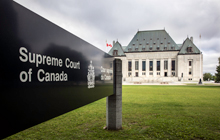Case Commentary: Glencore v. Canada — How are commitment and break fees in M&A transactions taxed? Windfall or business income?

When the Supreme Court of Canada denied Glencore’s leave to appeal, it ended a 30-year tax dispute, and characterized complex M&A fees as business income
 |
David J Rotfleisch, CPA, JD is the founding tax lawyer of Taxpage.com and Rotfleisch & Samulovitch P.C., a Toronto-based boutique tax law corporate law firm. |
IN MARCH 2024, the Supreme Court of Canada denied the application for leave to appeal by Glencore Canada Corporation, the taxpayer, against the Canada Revenue Agency, finally closing a tax dispute that had been dragging on for almost 30 years.
It all started in 1996 when Falconbridge Ltd. (Falconbridge), the predecessor of Glencore, offered to acquire the shares of Diamond Fields Resources Inc. (DFR) for $4.1 billion. Under the terms of the offer, DFR agreed to pay Falconbridge a Commitment Fee of $28.2 million upon DFR's execution of the offer. A bidding auction took place and Falconbridge lost to another bidder. Under the terms of the offer, DFR paid Falconbridge a Non-Completion Fee (also known as break fee) of $73.3 million in addition to the Commitment Fee, as a result of DFR's failure to follow through with the offer. In total, DFR paid Falconbridge $101.5 million in 1996.
The CRA assessed the 1996 income of Falconbridge and the Fees were included in the taxpayer's business income of the year. Falconbridge objected to the assessment in 1997, arguing that the Fees were extraordinary receipts not from a source, which is not taxable, or in the alternative were capital gains, which are not fully taxable. The CRA reassessed Falconbridge in 2001, maintaining it position of including the Fees in the taxpayer's business income, for which Falconbridge objected again in 2001. The CRA reassessed again in 2013, keeping its position unchanged. The taxpayer (now Glencore) appealed the reassessment to the Tax Court of Canada and the case was decided by the TCC in 2021, upholding the CRA's determination that the Fees were business income in accordance with subsection 9(1) of the Income Tax Act. Glencore appealed the judgment to the Federal Court of Appeal (FCA) and the case was decided by the FCA in January 2024, concluding that the fees were to be included in income from business and property, pursuant to a different provision which is paragraph 12(1)(x) in the ITA.
The fees were inducements in the course of business
Glencore argued that because it was in the business of exploration, extraction and refinery of ore deposits, the fees from an M&A transaction were not linked to its business activities. Furthermore, the Commitment Fee was $28.2 million and the break fee was $73.3 million, much higher than $15.3 million of the actual costs associated with the bid to acquire DFR. Thus, the fees according to the taxpayer served as a deterrent to the offeree from backing out of the deal, not a compensation to the offeror for the failed deal.
Regarding the capital property aspect, Glencore contended that the fees were not linked to a disposition of any capital properties in order to give rise to capital gains. In the alternative, the fees could be said to arise from the disposition of Glencore's right to the acquisition under the offer.
The TCC dismissed the arguments of the taxpayer, following the decision in Ikea, [1998] 1 S.C.R. 196. In Ikea, Ikea received a tenant inducement payment from a mall for entering into a long-term lease. The payment was held by the SCC to be on revenue account. Drawing from Ikea, the TCC in the case at bar seemed to interpret the definition of business activities very broadly, stepping outside of the tax context into the business or economic theory of corporation, when it said that the overall objective of a corporation is to bring in revenues for its shareholders.
The FCA drew a distinction between Glencore and Ikea. The Supreme Court in Ikea [had] correctly characterized the tenant inducement payment to be business income because the payment received by Ikea resulted from entering into a long-term lease. The lease was indeed inextricably linked to the ordinary business activities of Ikea which was to sell merchandise in physical stores. [However,] the fees received by Falconbridge resulted from an M&A transaction, where its ordinary business activities were mineral exploration, extraction and refinery. The FCA also drew a distinction with Morguard, 2012 FCA 306, where the ordinary business of the taxpayer was to purchase and sell companies and the fees associated with M&A transactions were therefore the taxpayer's business income.
The FCA instead relied on paragraph 12(1)(x) which provides that an amount received as an inducement during the course of earning income from a business or property shall be included in income. First, the FCA found that the fees were inducements for Falconbridge to make the offer, so as to trigger a bidding war and to fetch the highest price. The term "inducement" can have an encompassing meaning, contained within it a compensatory and an insurance component, to compensate the bidder for the lost time and effort and opportunity cost and to protect the bidder against potential risks, such as disclosure risk and reputational risk. Second, the term "during the course" can be interpreted to mean "in connection with", "incidental to", or "arising from". While negotiating an M&A deal was not an ordinary business activity of Falconbridge (or most businesses), it was certainly during its course of business, to acquire nickel deposits. Therefore, the fees were included in the taxpayer's business income, pursuant to paragraph 12(1)(x) of the ITA.
Glencore sets a precedent as to how the commitment fee and the break fee in M&A deals should be characterized. The conclusion by the FCA did not change the ultimate treatment to the fees held by the TCC that the fees were to be include in taxable business income. However, for most businesses that do not engage in M&A as an ordinary activity, these fees are inducements, included in income. For businesses that otherwise involve in M&A on a regular basis, such as private equity funds or investment banks, these fees are regular business income. M&A transactions are inherently complex, with many revolving pieces and fees.
David J Rotfleisch, CPA, JD is the founding tax lawyer of Taxpage.com and Rotfleisch & Samulovitch P.C., a Toronto-based boutique tax law corporate law firm and is a Certified Specialist in Taxation Law who has completed the CICA in-depth tax planning course. He appears regularly in print, radio and TV and blogs extensively.
With over 30 years of experience as both a lawyer and chartered professional accountant, he has helped start-up businesses, cryptocurrency traders, resident and non-resident business owners and corporations with their tax planning, with will and estate planning, voluntary disclosures and tax dispute resolution including tax audit representation and tax litigation. Visit www.Taxpage.com and email David at david@taxpage.com.
Read the original article in full on Taxpage. Author photo courtesy Rotfleisch & Samulovitch P.C. Title image: iStock (Supreme Court of Canada).










(0) Comments